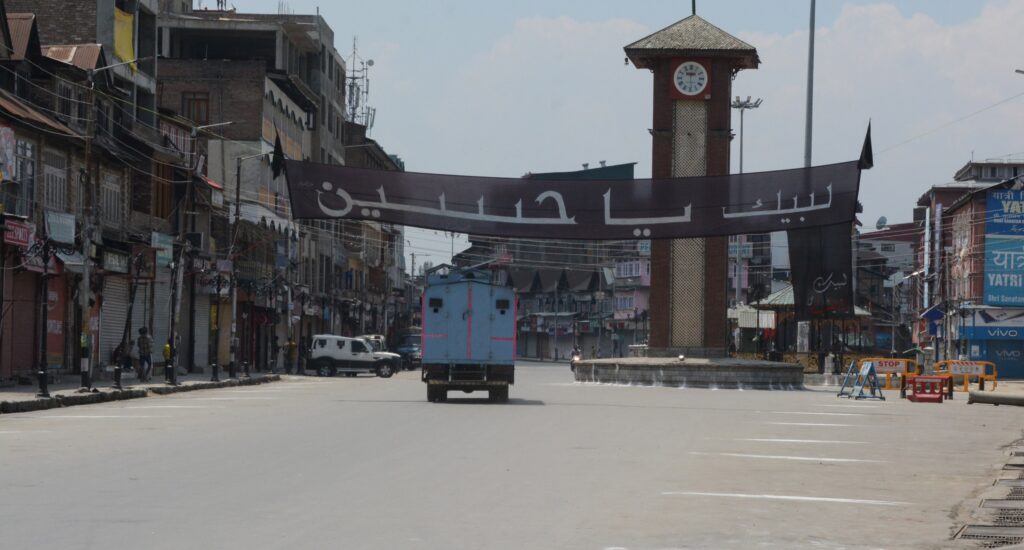It’s a rich blend of religion, culture, rituals and cups of noon chai.
Saqib Mugloo
For 82-year-old Ghulam Hussain, the month of Muharram means relief and days of free therapy. Hussain, a resident of Srinagar’s Lal Bazar neighbourhood, is among the 10 percent population of Kashmir and over 400 million global Shia population who commemorate the days of first month of Islamic calendar grieving and spending time in the remembrance of Prophet Mohammad’s grandson, Hussain Ibn Ali.
Ghulam Hussain has witnessed the changing patterns of Muharram processions and also the introduction of new rituals. He was six years old when Muharram processions were first banned in 1946, the then government imposing Section 144 of CrPC to prohibit public assembly in view of the ‘Quit Kashmir’ movement. Not a single procession was allowed that year; the ban, however, lasted only for a year.
Although he does not remember much, Ghulam Hussain said that later as he grew up people would talk about it. “It became a talking point among us and was cited as an example that we should be very careful about not doing anything that would result in any further ban,” he recalled.
What he remembers vividly though is how Sheikh Mohammad Abdullah resolved years of infighting among two Shia factions of Kashmir. In 1978, Abdullah, then the chief minister of Jammu and Kashmir, persuaded two factions of the Shia community to lead the Ashura procession alternately.
This Muharram, Ghulam Hussain carried an alam – a flag associated with Hazrat Abass who was killed at Karbala on the tenth of Muharram in 680 – saying that he would continue to do so as long as he could. “People tell me to not carry the alam because I am old and weak. But I always tell them that as long as God has given me life, I would continue to serve Abass,” he said.
Before the inception of militancy in Kashmir, mourners would carry out two huge processions through the heart of Srinagar city: one on the 8th of Muharram that would commence from Karan Nagar and end up in Dalgate and the other one on the 10th of Muharram which would be taken out from Abi Guzar and would conclude at Zadibal.
Today the distance of processions is a meagre two kilometres and it passes through the interiors of Zadibal area.
Ghulam Hussain remains grateful as the government had previously disallowed even the procession through the Zadibal interiors for two years due to the COVID19 lockdowns in 2020 and 2021. During past years, the government also used force against mourners who defied restrictions leading to injuries to hundreds.
“At least this year we were able to carry out processions without any restrictions,” Ghulam Hussain said.
Much like every Shia Muslim, Hussain participates in all rituals. His love, though, is reserved for Kashmiri marsiya – elegies – which are slowly losing popularity among the youth. “Kashmiri marsiya are soul enriching, if only you can understand what is being said,” he explained.
Marsiya in Kashmiri are divided into four segments: hamd, naat, madah and dard. Hamd involves talking about Allah and his greatness and is recited at the beginning. After that the qualities and praises of the Prophet are mentioned in naat by a speaker, followed by madah which talks about Hazrat Ali. dard is about the story of what transpired at Karbala on the 10th of Muharram in 680.
Ghulam Hussain loves marsiya and hopes the youth will learn it and reserve this rich culture. “Youth love nouhas and mostly those that are recited in Urdu, I wish they realise the beauty of Kashmiri marsiya and once they do, they will never think of anything else when it comes to mourning,” Hussain said.
What Ghulam Hussain felt remains a widely discussed concern during Muharram days for years now. Every year, youth and elderly hold high temperature debates over the Kashmiri marsiya and other rituals imported from other parts of the world. This year, prominent Shia leader Aga Syed Hadi, criticised the youth who sport long hair and recite Urdu nouhas.
Hadi went a step further and raised concern over the invitation of non-local mullahs during Muharram days. “You won’t be able to handle them. Don’t bring these (non-local speakers) here,” Hadi, who has a huge following on social media, said.
In another of his videos, he urged not to copy “the culture of others.” “We are Kashmiris,” he said.
He also criticized the youth who copy the style of alams from Pakistan. Pakistanis raise huge alams, and over the past few years with the advent of social media, Kashmiris have started to do the same. His criticism came after a youth who was raising a banner died of electric shock.
The revolutionizing social media, which has helped in introducing different cultures and experiences, is now pioneering a change in the mourning that was traditionally done in Kashmir. The young now seem to be adapting to a completely new genre of mourning, leading to an intense debate within the community.
The older generation of Shia Muslims, like Ghulam Hussain and Hadi, have strong opinions that Kashmiris should preserve their culture when it comes to mourning rituals. However, many youngsters differ on that and believe mourning rituals should not be seen through the prism of demography or race.
“I respect Hadi sahab, but for him to criticise youth over their mourning practices is just too much,” said 23-year-old Asif Ali, whose views are echoed by many on social media who justified adopting mourning rituals from other parts of the world. “Their way of mourning is something that resonates with the youth and their style is unique too. And in no way does it lead to any disrespect to the symbols of mourning,” a social media user posted.
Pakistani nouha (lyrical lamentation) and other forms of mourning have a huge fan base in Kashmir. The Chakwal style of mourning, which is intense and involves unique style of chest beating, is now famous among many Kashmiri Shia youth. “Although following their style requires more effort and energy, one feels satisfied at the end of it as we feel we have done justice to the rituals,” said Mohammad Younis, a fan of Chakwal style of azadari.
The fan following of Pakistani-born Sydney-based nouhakhwan Nadeem Sarwar also seems to be increasing with every passing year. Sarwar, whose nouhas garner millions of views on social media platforms, is one of the favourites among the lovers of the Prophet’s family when it comes to reciting their tragedies.
Sarwar’s evocative voice can be heard as soon as the Muharram moon is sighted. People tend to wait for his nouhas as he releases them over the course of days. In Kashmir, many areas recite his nouhas and then post on the social media. “He is the king and will remain so,” said Muneer Hussain, a nouha reciter himself.
Muharram This Year
As is the case, at the beginning of Muharram this year again saw some clerics discredit Karbala and rituals involving Muharram. “There was no stoppage of water in Karbala, these people (Shias) exaggerate what happened in Karbala,” one animated mullah said on social media.
Soon a barrage of comments and videos came forward from various schools of thought, which led the cleric to apologise. The event barring a few counter comments and videos did not lead to anything unpleasant.
However, what became a hot topic during Muharram was the disallowing of the procession on 8th Muharram. According to sources, one Shia leader during a meeting with the administration had demanded the procession to be banned.
The 8th of Muharram procession used to be taken out under the leadership of Maulana Abass Ansari. However, since 1989, the government has banned the procession and every year scores of youth defy the restrictions and take out small processions that invariably leads to tear gas shelling by the government forces.
A section of Shia populace believed that some Shia leaders had deliberately called for the processions to be banned, “They termed the 8th Muharram procession as a nuisance and one taken out by anti-nationals. Thus making sure that it is banned,” a youth who did not want to be identified said.
In recent years, scores of youth have been detained, over a dozen booked under anti-terror law UAPA for raising pro-freedom slogans during Muharram. This year, the police said no force was used against mourners and that nobody was detained.
In a statement, Jammu and Kashmir police said that restrictions were imposed in the jurisdiction of eight police stations of Srinagar and one route was prohibited to ensure law and order situation did not arise.
The statement reads that some youth sporadically tried to come out individually at certain places but were taken into preventive custody without using any force.
“Neither any anti-national slogan nor any communal slogan was heard today. Thus no case was registered unlike last year’s 8th Muharram,” the police said.
Beyond debates and discussions over the mourning rituals, food and piping hot cups of tea are a part of life in Muharram.
Food is a major part of Muharram culture and nothing can beat the taste of noon chai (pink salt tea) in the night just after the completion of the mourning ritual. The mourning after 7th Muharram extends till morning prayers and tea comes to the rescue of those who tend to doze off early, as it keeps them awake. “Noon chai is the best at night, and when taken with crispy Kashmiri bread, it’s pure bliss,” said Tasaduq Hussain.
A large amount of food is given as niyaaz (charity) during Muharram. This involves the Kashmiri wazwan. However, what everyone waits for is the tea served by the volunteers. In Srinagar’s Alamgaribazar neighbourhood, volunteers from Hussaini Khidmatgar Committee serve boiling hot tea during evening hours of Muharram in their vehicle that has all the facilities including gas and stove.
A volunteer said that the committee serves tea and bread worth millions of rupees in Muharram. “We make sure we serve the best tea and that is why most people in the area love to have it with us,” he said.
Sunni Muslims also volunteer, serving tea and juice to mourners in Shia neghbourhoods as well as their own.
While controversies and debates will continue to be a part of Muharram discourse, the cultural part of it will continue to amuse people irrespective of their ideological leanings.


